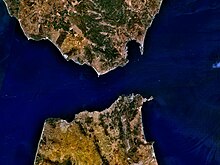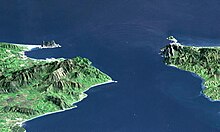Strait of Gibraltar crossing: Difference between revisions
clean up and general fixes using AWB |
Davejenk1ns (talk | contribs) |
||
| Line 17: | Line 17: | ||
A bridge spanning the Strait of Gibraltar is described in [[futurist]] author [[Arthur C. Clarke]]'s 1979 [[science fiction]] novel ''[[The Fountains of Paradise]]''. |
A bridge spanning the Strait of Gibraltar is described in [[futurist]] author [[Arthur C. Clarke]]'s 1979 [[science fiction]] novel ''[[The Fountains of Paradise]]''. |
||
{{wide image|Straße von gibraltar panorama V1.jpg|1000px| |
{{wide image|Straße von gibraltar panorama V1.jpg|1000px|Looking South from [[Mirador del Estrecho]]. In the East is [[Ceuta|Ceuta/Sabta]] and in the West [[Tanger|Tandja/Tanger]].}} |
||
==Tunnel== |
==Tunnel== |
||
Revision as of 16:02, 26 October 2013
This article has multiple issues. Please help improve it or discuss these issues on the talk page. (Learn how and when to remove these messages)
|

The Strait of Gibraltar crossing is a hypothetical bridge or tunnel spanning the Strait of Gibraltar that would connect Europe and Africa. The governments of Spain and Morocco appointed a joint committee[1] to investigate the feasibility of linking the two continents. This resulted in the much broader Euromed Transport project.[2]
Bridge
Several engineers have designed bridges on various alignments and with differing structural configurations. Professor T.Y. Lin’s proposal for a crossing between Point Oliveros and Point Cires featured deep piers, a length of 14 kilometres (8.7 mi), 910 metres (3,000 ft) tall towers, and a 5,000 metres (16,000 ft) span, more than twice the length of the current longest bridge span.[3]
In 2004, architect Eugene Tsui published his concept for a floating and submerged bridge, connected at a three-mile wide island in the middle of the Mediterranean Sea.[4]
In 2004, the Science Museum published an image of the proposed Gibraltar Straits road bridge.[5][clarification needed]
A bridge spanning the Strait of Gibraltar is described in futurist author Arthur C. Clarke's 1979 science fiction novel The Fountains of Paradise.
Tunnel
Various Gibraltar tunnels have been proposed. Spain first proposed a modern tunnel under the Strait of Gibraltar in 1930. A major problem arose when the engineers hired by the Spanish government discovered that the material under the Strait was extremely hard rock, making tunnelling impossible with the available technology.[6] One engineering solution was to fix, using cables, a prefabricated concrete tunnel to the floor of the Strait. This tunnel would handle automotive and train traffic. Nothing came of this proposed solution.[7]
A 2008 geological study cast doubt on the tunnel's practicality. In March 2009, a contract was issued for a joint system linking the Moroccan Société Nationale d'Etudes du Détroit de Gibraltar (SNED) with its Spanish counterpart, Sociedad española de estudios para la comunicación fija a través del Estrecho de Gibraltar S.A (SECEGSA). A three-year study for a railway tunnel was announced in 2003. SNED and SECEGSA commissioned several sea-bed surveys.
The Strait depth extends to 900 metres (3,000 ft) on the shortest route, although it is only about 300 metres deep slightly further west, where the European and African plates meet. The shortest crossing is 14 kilometres (8.7 mi). The proposed route of 23 kilometres (14 mi) is west of Tarifa and to the east of Tangier. The tunnel is likely to be about 34 kilometres (21 miles) in all, and an additional rail line would be needed to link the Spanish end of the tunnel near Tarifa to Algeciras, where the current Talgo train-hotel service currently terminates.[citation needed]
A report[8][9][10] on the feasibility of the tunnel was presented to the EU in 2009. A further study of project is under development by a group of specialised consultants from SYSTRA, Amberg and COWI.
Planning

In December 2003, Spain and Morocco agreed[11][12] to explore the construction of an undersea rail tunnel to connect their rail systems. The tunnel would have linked Cape Malabata near Tangier with Punta Paloma 40 kilometres (25 mi) west of Gibraltar.[13] In late 2006, Lombardi Engineering Ltd, a Swiss engineering and design company, was retained to draft a design for a railway tunnel.[14] According to the company, the main differences between the construction of this tunnel and that of the Channel Tunnel, linking France and Great Britain, are the depth of the sea and the geological conditions. The area under the Strait is less stable than that under the English Channel. An active major geologic fault, the Azores-Gibraltar Transform Fault, bisects the Strait, and severe earthquakes have occurred in the area. The presence of two deep Quaternary clay channels in the middle of the Strait makes construction complex,[8] causing doubts about the feasibility of the project and proposals for an exploratory tunnel.[15]
It is projected to carry 9 million passengers in its first year of operation, expected to be 2025. No official figures about the cost of the project had been announced by 2007, but previous estimates exceeded five billion Euro.[16]
Technical aspect
The proposed rail tunnel's length is 40 kilometres (25 mi), 300 metres (980 ft) deep,[9] and its construction would take 15 years. An earlier plan was to link the two continents via the narrowest part of the strait, but this idea was dismissed as it is 900 metres (3,000 ft) below sea level and the deepest undersea tunnel, the Eiksund Tunnel, is 287 metres (942 ft) below sea level.
The construction of terminals, such as the Eurotunnel Folkestone Terminal and Eurotunnel Calais Terminal at either end of the Channel Tunnel, might be required for trans-shipment of road vehicles.
See also
References
- ^ [1]
- ^ Euromed Transport project 2003 – 2009
- ^ "Gibraltar Bridge – Feasibility Study". OPAC Consulting Engineers. 2003. Retrieved 5 March 2009.
- ^ "Strait of Gibraltar Floating Bridge". Tsui Design & Research, Inc. 2004. Retrieved 5 March 2009.
- ^ Suspension bridge technology
- ^ "Tunnel from Spain to Africa" Popular Mechanics, March 1930 article bottom-left of page 366
- ^ "Strangest Tunnel to Join Europe and Africa" Popular Mechanics, August 1930
- ^ a b "Project of the fixed link through the strait of Gibraltar" (PDF). SECEG SA. November 2007. Retrieved 3 February 2009. [dead link]
- ^ a b Wood, Danny (19 July 2008). "Spain-Africa link decision 'near'". BBC News. Retrieved 20 July 2008.
- ^ "El proyecto del túnel del Estrecho llegará en 2009 a manos de la UE en busca de apoyos". 20 minuto.es. 16 November 2008. Retrieved 3 February 2009. Template:Es
- ^ "Europe-Africa rail tunnel agreed". BBC News. 14 December 2003. Retrieved 3 February 2009.
- ^ "Africa and Europe set for tunnel link". BBC News. 13 March 2007. Retrieved 3 February 2009.
- ^ "Spain and Morocco agree to rail tunnel under Gibraltar strait". wsws.org. Retrieved 10 January 2007.
- ^ swissinfo with agencies. "Swiss plan tunnel under Strait of Gibraltar". swissinfo.org. Retrieved 10 January 2007.
- ^ "Doubts cast over tunnel plan". Middle East Online. 29 September 2008. Retrieved 3 February.
{{cite news}}: Check date values in:|accessdate=(help) - ^ Tremlett, Giles (20 October 2006). "By train from Europe to Africa – undersea tunnel project takes a leap forward". The Guardian. London. Retrieved 10 January 2007.
External links
- "Gibraltar: Tunnel under troubled waters". 30 June 2008. Retrieved 3 February 2009.
- A man from Ticino to link Europe and Africa
- "Website of the project of the fixed link through the Strait of Gibraltar". Archived from the original on 16 May 2007. Retrieved 3 February 2009.
- SNED
- SECEGSA

